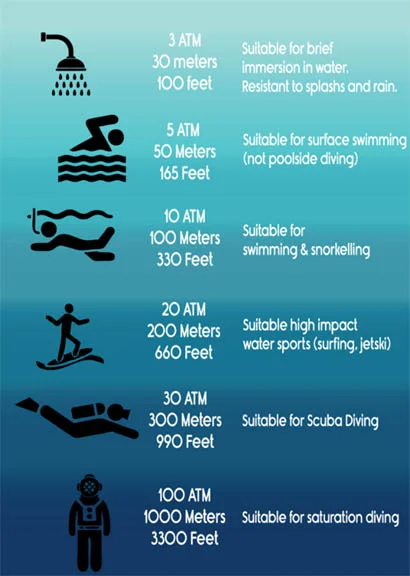It often seems we get this question on a daily basis. I'm guessing the following information will surprise you.
There's no such thing as a waterproof watch. When subjected to enough pressure for enough time, every watch will eventually fail. Some watches, however, will take longer to break than others. Those watches are water-resistant, and their water-resistance (in terms of atmospheres or meters) is a measure of how much pressure it takes to damage the watch.
Here's how Citizen Watch explains 'water resistency'- Water resistance is measured at a static, or motionless state. As the watch is moved in water, such as from the motion of swimming, pressure is added from velocity. While you may be swimming in a pool at surface level, the watch may be experiencing forces equal to 3 BAR (ATM). Diving into a pool can cause pressures on the watch in excess of 3 BAR (ATM).
Let me explain that so it's clear. Let's say I have an Casio Ironman Triathalon watch that says it's water resistant to 100 meters, which is approximately 3 BAR (ATM). Does that mean I can safely dive 100 meters deep into water and expect my watch to be water resistant?
No.
You see, water resistancy is not really about how deep you can safely go into water with your watch, but how much water pressure the watch can take. So, let's say you're wearing your watch, which says it's resistant to 100 meters, and you, naturally, figure you can safely dive into a pool that's only 30 meters deep. The problem occurs because, when you are diving, you are moving, which creates additional pressure. The amount of pressure you create by diving, added to the amount of pressure created by the water, may exceed the 3BAR limit of resistancy.
And that is if all your gaskets are brand new and in ideal condition. More from Citizen Watch Co.-
"A primary factor about water resistance to keep in mind is that it is not a permanent condition. When a piece is new, it meets the specifications for water resistance as indicated on the case back. However, as the watch ages, the gaskets which seal the watch become dry and brittle diminishing its water resistant quality. Exposure to environments such as chlorinated pools, salt water or soaps from showering can accelerate drying of the gaskets. We recommend that the gaskets be changed at least every 18 months to maintain the water resistant quality of your timepiece. If the watch is exposed to chlorinated pools, soaps salt water, etc. on an occasional basis, we recommend that the gaskets be changed on a yearly basis. If the watch is exposed to the previously mentioned environments on a daily basis, we recommend the gaskets be changed every six months to insure the water resistant quality".
Some other things to keep in mind- Understandably, most people only concern themselves with the gasket on the caseback and don't consider the gaskets on the crown (the little knob on the side of the case you use to adjust the time) or the gaskets on any buttons the watch may have. Often times, when moisture enters a watch, it's through the hole in the case where the stem goes in (the stem is attached to the crown).
One last thing concerning a Sauna, Jacuzzi or hot tub.
The various components used in the manufacture and assembly of your watch expand at various rates. The rapid change in temperature when entering a Jacuzzi or hot tub could result result in a loss of the sealing capabilities of gaskets, which may allow moisture to enter. In addition, heat from these sources can cause deformation of certain materials leading to mechanical failures. For these reasons, you should remove your watch before entering a sauna, hot tub or Jacuzzi.
So, the answer is "no", your watch is not "waterproof". We're sorry.


